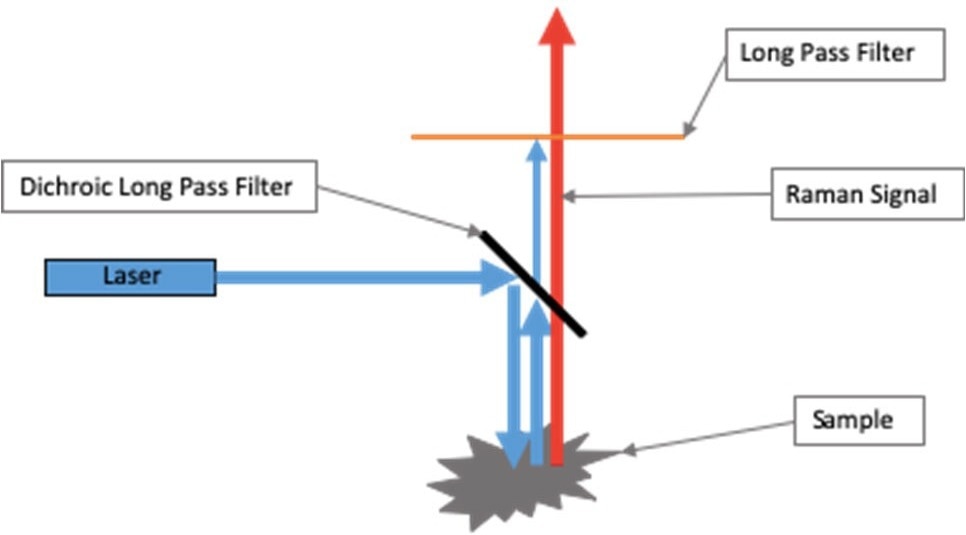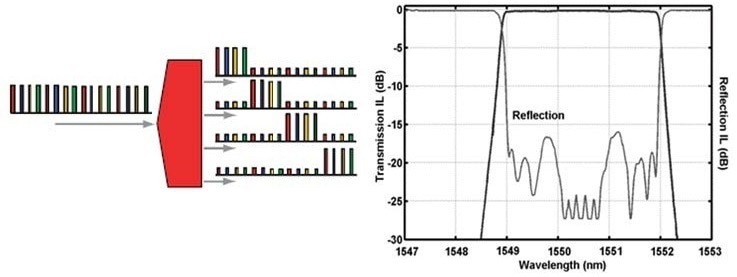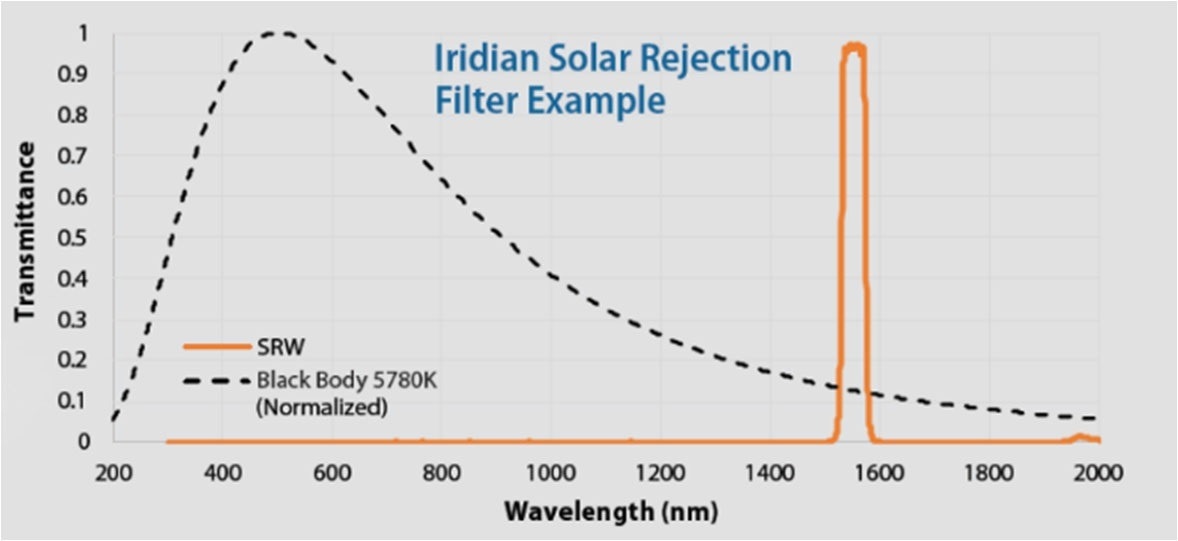Remote sensing, optical communications, astronomy, and bio/chemical and molecular analysis employ photonics technologies to filter out the desired information (such as telecommunication signals or images of cells or galaxies) from undesired background noise (including ambient light or other communication signal bands) by maximizing the amount of light transmitted to the photodetector from the spectral band of interest. The amount of “out‐of‐band” light received by the same photodetector is kept to a minimum.
Signal-to-noise ratio (SNR or S/N) is most commonly used to analyze electrical signals. It is defined as the ratio of the power of signal (desired input) to the power of background noise (undesired input).

In some environments, the signal power cannot be controlled or increased. In such a case, users can improve this ratio by reducing the background noise so that the desired information can be better discriminated from the undesired background.
Optical filters offer wavelength selectivity that delivers more signal and less background to these photonics applications, amongst many others.
Optical Filters in Spectroscopy
One prime example in which optical filters are used to deliver “more signal, less background” is Raman spectroscopy, where a unique spectral fingerprint is obtained from the inelastic scattering of photons that have lost, or (in fewer cases) gained, energy through interaction with vibrational modes of the sample of interest.
This fingerprint can help identify the molecules present. While it is extremely beneficial, this non‐destructive molecular analysis technique is highly challenging. Raman scattering is only experienced by approximately one in a million photons incident on a molecule will have the associated shift in wavelength. The elastically scattered (Rayleigh) photons will be present in the detection path at a wavelength that matches the incident light.

Image Credit: Iridian Spectral Technologies
The challenge lies in selecting the spectral information (signal) of that one photon from the very noisy background signal. High-performing wavelength-selective optical filters can provide a solution to this.
An optical edge pass or notch filter will be located in the detector path of most Raman systems. As passive components, optical filters cannot boost the weak Raman signal. However, they can be designed and manufactured to minimize any loss in the Raman signal region (at a longer wavelength than the incident light).
The main action of an optical filter is suppressing the background noise at the wavelength of the incident light by providing broad and deep spectral blocking of the laser source, often to six or more orders of magnitude, allowing the system to achieve a higher SNR.

Image Credit: Iridian Spectral Technologies
Remote Sensing
Managing and controlling a system depends on the ability to monitor the system and measure how it changes over time, providing a feedback loop to the control system.
In photonics, this principle is realized in a variety of applications, from remote sensing and earth observation (EO), which provide satellite imaging of environmental phenomena, natural disasters such as fire and floods, and the effects of forestry and agricultural practices, to machine vision and its ability to analyze samples under test.

Image Credit: Iridian Spectral Technologies
Every sensing/imaging application relies on the spectral difference in the transmission, reflection, and absorption of the materials or phenomena (such as gases).
In non‐dispersive infrared (NDIR) gas detection systems, an example of remote sensing, a measurement of background mid‐wave infrared (MWIR) light is made and subsequently compared to the measurement in the presence of a gas of interest. Narrowband optical filtering is required to ensure that the only light at the detector is from the absorption band corresponding to the gas in question. This results in more signal and less background.

Image Credit: Iridian Spectral Technologies
EO systems use a camera/detector seeking to image at a specific wavelength band (or bands in the case of multi‐spectral imaging (MSI)) corresponding to the science line of interest’s associated reflectivity or emission.
This could be broad spectral bands in the visible/near-infrared range associated with terrestrial objects such as rocks, water, or vegetation (such as ESA’s so-called “SENTINEL‐2” bands), or it could be a single oxygen triplet at 777.4 nm, which indicates the presence of lightning.

Image Credit: Iridian Spectral Technologies
The desire, in any case, is to achieve easy discrimination - more signal, less background ‐ between the light detected in the band of interest and the background, including solar background, ambient light, and the light from neighboring spectral bands in MSI systems. This is achievable using individual high-contrast bandpass filters or a series of filters arranged as a multi‐zone filter array, These would provide the necessary wavelength selectivity.
Astronomy
Instead of looking down from the skies as in EO, astronomy turns the focus to the great beyond.
Seeking patterns and meaning in the night skies is a practice dating back to many ancient cultures, and has given us the constellations that are known today.
The Dragonfly Telephoto Array maintains this tradition by probing the skies in the hopes of answering one of the biggest questions in astrophysics: what is the nature and distribution of dark matter?

Image Credit: Iridian Spectral Technologies
Dragonfly aims to answer this by using a camera array to view the image formed by narrow emission lines provided by the diffuse, low-surface brightness gas forming in the intergalactic medium.
To achieve this, it requires individual very narrow bandwidth (<1 nm) optical filters positioned in front of each camera lens to selectively resolve these bands from the background atmospheric and “night‐sky” lines.
These filters generate wavelength selectivity, which is much more angle tunable and precise to each element of Dragonfly’s compound “eye” than is possible with conventional astronomical filters. This provides more signal and less background to this revolutionary telescope.

Image Credit: Iridian Spectral Technologies
Communications
The above examples used the word “signal” to mean the spectral line or image associated with a specific phenomenon.
Optical filters for communication applications, including terrestrial datacom and telecom and extra‐terrestrial Satcom, facilitate transport and routing of communication signals.
In terrestrial fiber‐optic-based communication systems, such as long‐haul/metro telecom networks, and inside the massive cloud data server systems (datacom), including as much information onto a single fiber as possible enables the bandwidth and speed needed to support the vast amounts of communication data transported – whether for internet, phone and video streaming by individual users or increasing communications by and between inanimate devices making up the internet of things.
Wavelength division multiplexing (WDM) associates a certain communication transport signal with a corresponding wavelength band on the same fiber at once.
Optical fibers are frequently utilized to accomplish WDM, serving to add, drop, and single out a specific wavelength signal band of interest from the other signal bands continuing down the network to another information node or user destination.
This selectivity is defined by how many channels are selected without skipping neighboring channels to the band of interest – a 4 skip 0 filter transmits four signal bands and is steep enough to reflect the next channel band without loss.
More selective and steeper filters result in higher SNR in the network by giving high signal and low‐cross talk between signal bands.

100 G DWDM 4s0 band splitter in ADD/Drop module. Image Credit: Iridian Spectral Technologies
The principles of WDM also apply in the fast-growing market of Satcom, in which constellations of satellites are connected in orbit using free-space optical communications forming an orbiting network above.
The optical intersatellite links (OISL) employ WDM filters to pick out and direct the signal-carrying optical bands from the lasers to the corresponding detectors, albeit after traveling thousands of kilometers through space between the satellites.

Image Credit: Iridian Spectral Technologies
Specialized optical filters called “solar rejection filters or windows” (SRF/SRW) also play key roles in Satcom optical networks. While WDM filters distinguish one signal from another within the telecom signal “C‐band” (~1530 nm ‐1560 nm), SRF/SRW is the first line of defense in providing higher SNR. They exclude all but the C‐band wavelengths from entering the satellites while performing broad and deep blocking of solar/ambient background light above and below this relatively narrow signal band.
These filters are particularly difficult as they need to provide terrestrial telecom functionality in a much larger format (often up to around 100 mm in diameter or more compared to the miniature 1x1 mm fiber‐optic filter squares) while reducing transmitted wavefront error to a minimum. This ensures that the signal integrity is preserved as it travels over vast distances.

Image Credit: Iridian Spectral Technologies
These are just a few examples of applications improved by the use of wavelength-selective optical filters and why Iridian prides itself on working with customers to design solutions that enable them to achieve more signal and less background in their systems.

This information has been sourced, reviewed and adapted from materials provided by Iridian Spectral Technologies.
For more information on this source, please visit Iridian Spectral Technologies.